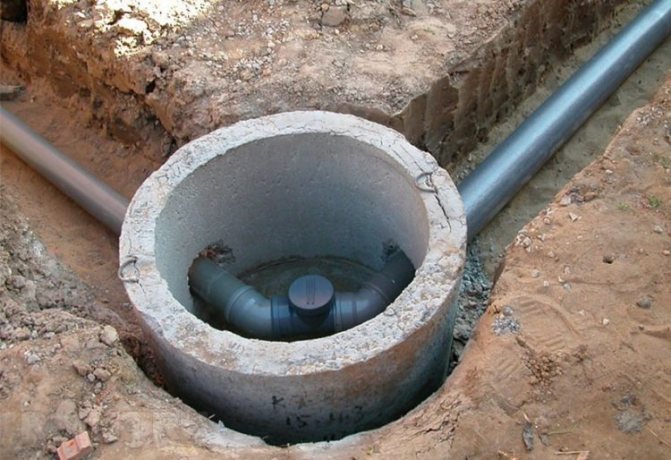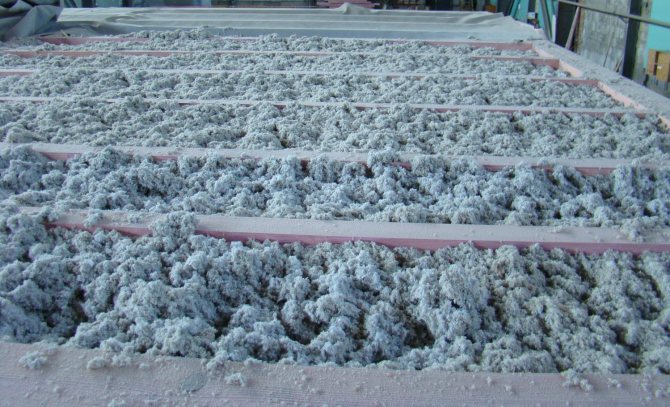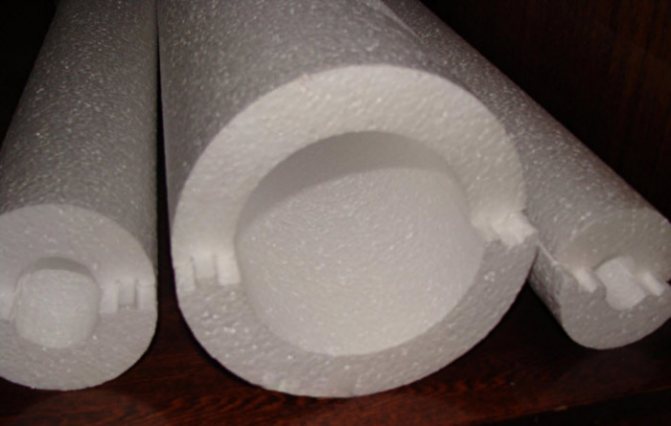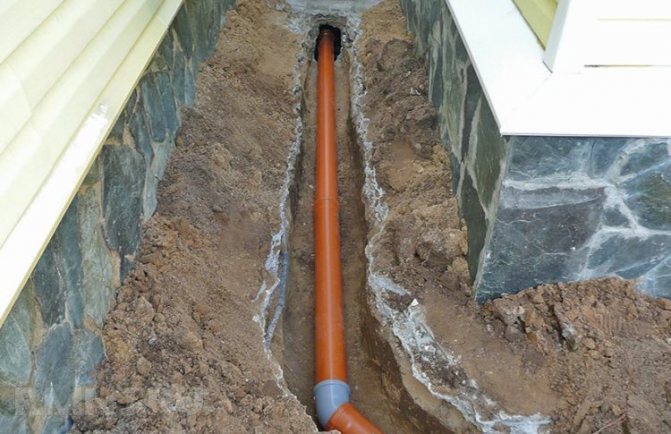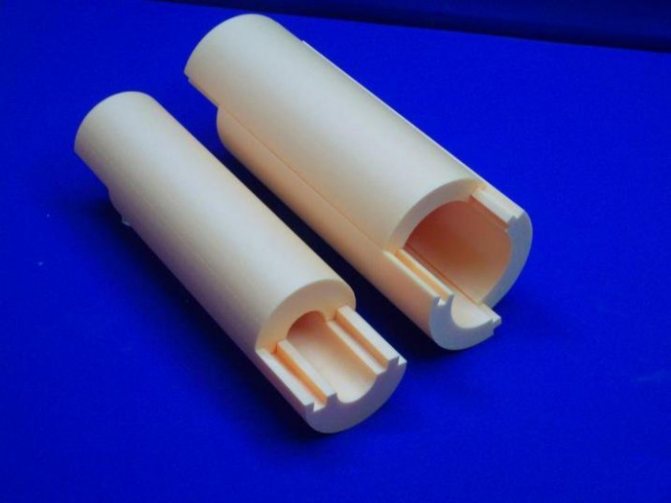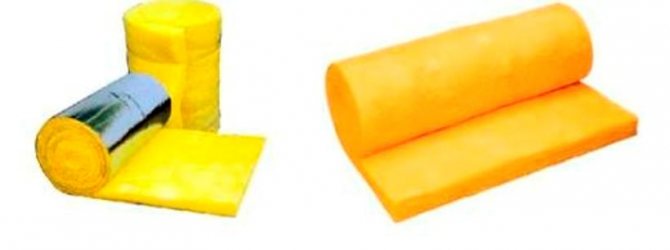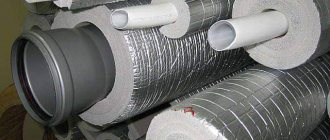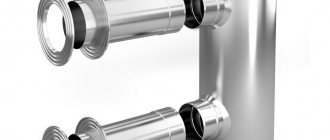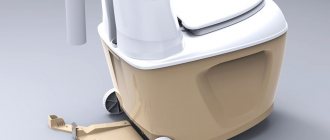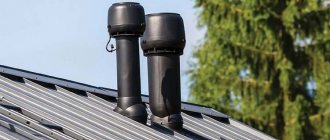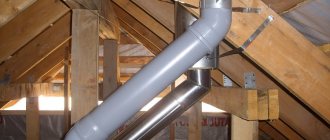Arrangement of a country house in the absence of communal plumbing and sewerage systems is a daunting task for any homeowner. In addition to providing residents with drinking water, it is necessary to solve the problem of draining gray water and sewage, while not forgetting about the insulation of the sewer pipes of the external sewage system.
This problem is solved in various ways; in order to choose the appropriate option, it is useful to know how the pipes of the external sewage system are insulated in the ground and to study this technology. This will allow for correct and long-term insulation of the sewage system with minimal time and financial losses.
Fig. 1 Sewerage of a private house - device
Is it necessary to insulate the sewer and problems with freezing pipes
When draining sewer and gray waters of a private house at subzero temperatures of the external environment, they can freeze, and this will cause the following unpleasant consequences:
- Frozen water will impede drainage from the home, thus creating significant difficulties for private living in the winter.
- Also, when defrosting, water expands, which causes damage to pipelines and clogging of the earth with sewage, which worsen the ecological situation.
- Ice plugs that prevent the outflow of contaminated water will cause it to stagnate in the drainage system - as a result, unpleasant odors will appear in the home, interfering with comfortable living.

Fig. 2 Map of the level of soil freezing - an example
Installation of thermal insulation of sewer pipes
Most of the materials used for insulation allow installation quite quickly. We are talking about those insulation models that completely repeat the shape of the pipes. They are simply enough to put on the product after its installation.
Before installing the thermal insulation, it is very important to check whether all stages of the installation of the pipe have been carried out correctly. If a leak has formed somewhere, it will wet the insulation and render it unusable even before it can show its good side.
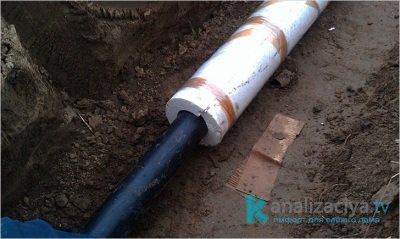

The installation of materials such as glass wool or improvised means must be taken care of even before the pipes are completely installed. Insulation is placed in the pit, only then pipes are placed in it and fixed to each other. Next, it is necessary to connect the edges of the insulating material, and thereby completely close the pipe.
Most types of thermal insulation are suitable for absolutely all pipe materials, so the choice is entirely up to you.
Insulation of sewer pipes of an external sewage system - generally accepted methods
When deciding how to insulate the sewer in a private house, they consider a number of methods, the main ones are:
- Deepening in the ground. To implement this method, a prerequisite is placing the pipe on the street in a trench below the maximum freezing point for a given area.
- Using an electrical cable. This technology of external sewerage insulation is easily implemented thanks to the manufacturer, who produces reliable moisture-resistant electric heating cables that are placed inside the pipeline or special slots in the pipes.
- The use of heaters. This method of thermal insulation can be quite simply implemented thanks to the manufactured casings made of various types of insulation with a diameter suitable for sewerage insulation.
- Combined methods. An excellent solution to thermal insulation of sewer pipelines is the use of additional insulation by placing them in a sheath of insulation at an average depth in the ground.Another common option is to place the heating electric cable in a sheath of insulation, while the sewer main is at a short distance from the earth's surface.
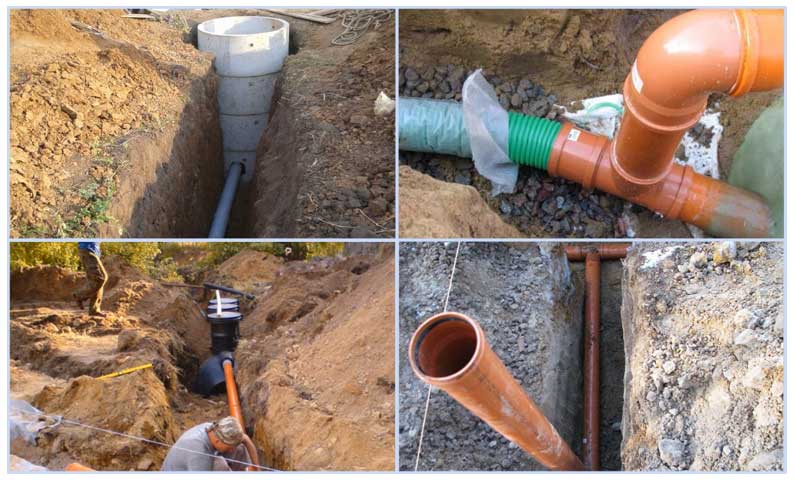

Fig. 3 Installation of pipes in a trench
Why do sewer pipes in the ground need to be insulated?
Some materials used for the manufacture of modern pipes do not need additional thermal insulation, and they themselves perfectly cope with the lowered temperature. This includes polyethylene or polypropylene, but even they sometimes do not withstand the harsh Russian frosts. Sometimes the temperature outside the window can reach -30 ° C, and the soil freezes even more.
Metal and PVC pipes are in dire need of additional thermal insulation when installed in the soil. The manufacturers themselves speak about this. The fact is that these materials are not only unable to provide a comfortable temperature for their work themselves, but they can also serve less than the due dateif they are constantly exposed to negative temperatures.
For example, the minimum temperature for comfortable operation of PVC pipes is only -15 ° C, and for our winter this indicator is considered even sparing.


Lack of proper thermal insulation will lead to freezing of the pipe. This happens especially often if the sewer system is not used for a long time. Sometimes a night is enough, during which the temperature outside the window will drop sharply.
The wastewater will quickly freeze. The water will turn to ice and gradually expand. It is no longer possible to use the sewer system, and besides, it is necessary to eliminate the breakdown as soon as possible, otherwise, from the expansion of the water, the pipe may simply burst. Insulation of sewer pipes in the ground solves all these problems.
Warming with the help of soil when laying the pipeline below the freezing depth
Insulation of sewer pipes in the ground by this method is the most affordable process, because in areas with a temperate climate, the depth of soil freezing is about 1.5 meters. When determining the depth, you can be guided by special maps of freezing of the earth for different regions, laying the pipeline below the freezing depth has the following features:
- When installing the pipeline in the middle lane or northern latitudes, a large amount of excavation will be required - this will lead to high financial costs.
- The volume of land sampling and costs will increase even more if the distance of the sewer main from the house is too large, because there is 110 mm along the entire route. the pipeline must provide a minimum technical slope of 20 mm. per running meter. Compliance with this condition leads to the fact that at a 50-meter distance, the height difference can reach one meter - therefore, the lowest point will be at a depth of 2.5 meters.
- The deep burial of the pipeline makes it difficult to carry out repair work in the event of damage.
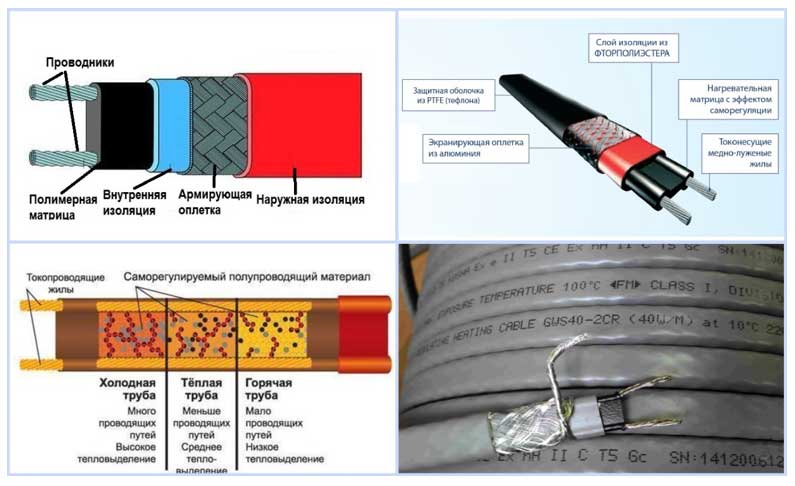

Fig. 4 Thermal insulation of the sewage system with a heating cable - type of wire
How to choose insulation
When using insulation, you should try to choose the material that is optimal in terms of its properties, taking into account the characteristics of the soil in which it will be laid.
In general, the types of insulation can be divided into several groups:
- Bulk;
- Rolled;
- Plate-leaf;
- Foam blocks.
When using the first type, the pipeline laid in a trench can simply be covered with expanded clay. This method of insulating sewer pipes in the ground with your own hands is the simplest and most inexpensive, but it is suitable only if the trench is dry. For roll and plate types of insulation, a protective waterproof box will be required. This is necessary to prevent the formation of ice plugs in cold winters.
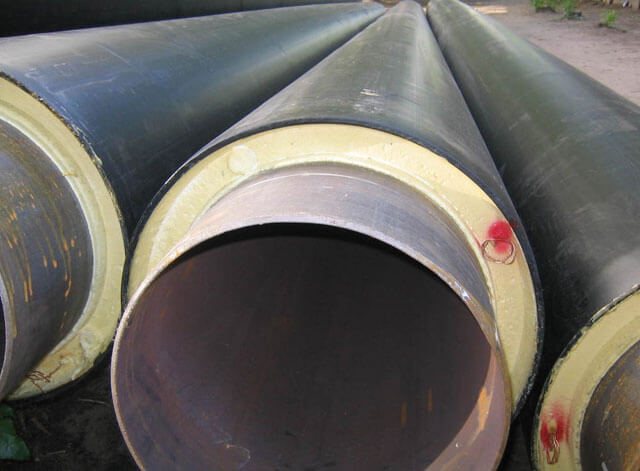

High-quality insulation of external sewer pipes is due to correctly selected material.The range of insulation materials for sewer pipes on the market is very wide and it is not so easy to make a choice. But what absolutely needs to be paid attention to is that the insulation is already waterproofed. In this case, there will be no need to worry about additional measures.
Heating of external sewerage using a cable
When deciding how to insulate sewer pipes in a private house, many choose a heating cable. During installation, it is placed along or wrapped around the pipeline, if strong heating is required, a common option is to place the heating wire inside the line. The use of electric heating has the following features:
- The electric cable is quite expensive, the price of one running meter is about 15 USD.
- With electric heating, it is possible to place the sewer mains in the ground not too deeply, the usual depth of its occurrence is no more than 0.5 meters and can be reduced by using a powerful electric cable with a small winding pitch.
- The heating wire can be placed in pipe channels specially made for laying it or attached to a plastic pipeline with foil adhesive tape with your own hands.
The main methods of insulation
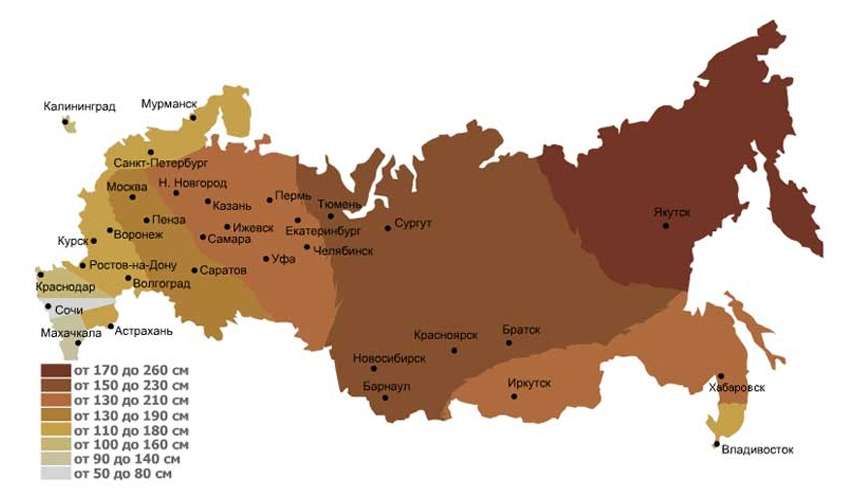

Freezing depth map
The most common ways to insulate a sewer pipe are:
- an engineering method, in which preliminary calculations are carried out and the highway is laid deeper than the soil freezes in a given region;
- active method - heating pipes with electricity using a cable;
- thermal insulation - the use of various artificial insulation materials or natural expanded clay.
Each method has pros and cons.
Laying sewers below the level of soil freezing
Not always a reliable and affordable method, since the length of the section will not allow you to maintain the required slope. This method may require a fairly large amount of money for construction work. Even if you use cast iron products that tolerate cold well, they will cost three times more, excluding the cost of work. It is also expensive to repair deep seated sewers. It is cheaper to buy synthetics and impose pipes.
Heat insulating materials
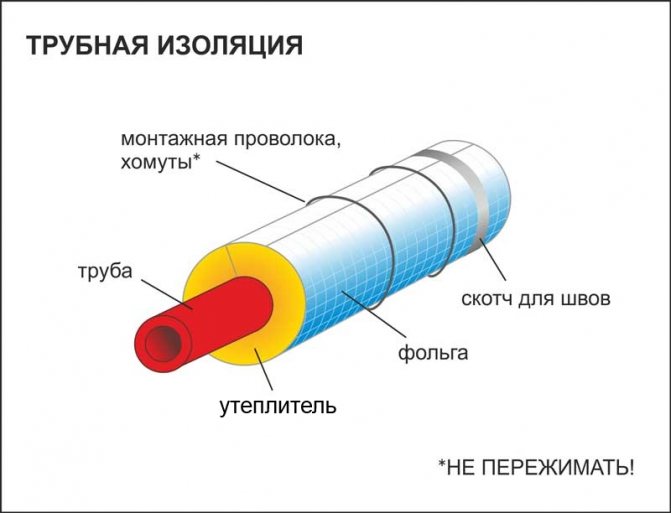

There are many different insulation materials that are wrapped around the sewer. Foamed polyethylene is most suitable for the basement. Its low density is not effective in soil.
Mineral wool is the most famous insulation, but not the most practical. When wet in the ground, it loses its qualities, so you need to take care of waterproofing. In a dry environment, this is a good option.
Penoizol is an expensive but resistant material that is suitable for underground insulation. Construction companies work with him, but many cannot afford it.
Penofol - simultaneously solves the problem of insulation and waterproofing, therefore it is often used when installing a sewage system. It's cheap.
Expanded clay - a natural material made of baked clay is also used as insulation. For this, a layer is poured under the pipes. After laying, the sewerage system is sprinkled on top, then soil is brought in and compacted. Expanded clay is resistant to moisture, therefore it is an ideal option for storm sewers.
Styrofoam is a cheap way, but you will need to build something in the form of a box around the highway, and then fill it with crumbs. The foam is often damaged by rodents, so it is recommended to line the pipes with a metal mesh with small holes.
Expanded polystyrene shell for pipes. Minimum thickness 25 mm, maximum 100 mm. Allows you to keep the sewerage system working when laid to a depth of 0.5 m at a temperature of -30 degrees.When applying the material to the joint, the places are wrapped with tape so that no shifts occur during sprinkling with soil.
Polyurethane foam shell is a material that is not sensitive to moisture. Service life up to 25 years. It is made in the form of halves that have a lock. They dress in turn and strengthen with tape. On top there is additional thermal insulation in the form of a foil layer.
Electric heating cable
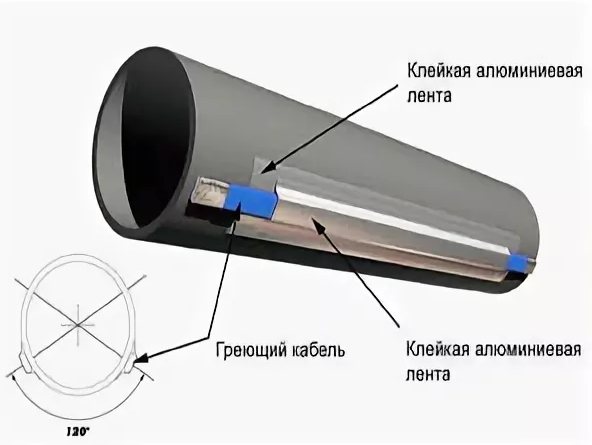

An electric cable of sufficient power is used in the country, where sewage is rarely used. By turning on the heating, the sewers not only maintain the desired temperature, but also defrost it so that the pipe does not break.
The cord must be placed along the pipe and wrapped with tape. Heating is regulated automatically. When the temperature drops below zero degrees, the sensor automatically turns on the heating system. It is possible to insulate sewer pipes in a private house with your own hands using an electric cable if you have experience, but in order to avoid electric shock, it is better to invite a master.
Sandwich pipes are ready-to-install sewer parts with pre-existing insulation consisting of several layers. This method is more expensive than buying plastic pipes and insulation separately.
Warming by means of heat-insulating materials
When determining how to insulate a sewer pipe on the street, insulation is often chosen with the help of insulation materials widely used in the construction industry. Usually, for ease of installation, they have a cylindrical shell with an inner diameter corresponding to the standard size of the sewer pipe.
Glass wool
The main heat insulator is long glass threads, which are obtained from broken glass by heating to 40 ° C and blowing from a centrifuge - this significantly reduces the cost of the manufacturing process.


Fig. 6 Glass wool insulation for sewer pipes
Fibers 3 - 15 microns thick. are suspended in an air environment, therefore the material has a low density and high resistance to vibration, in addition, glass wool has the following useful properties:
- The material is non-flammable, has high thermal stability and can withstand temperature ranges from -400 to +700 C.
- Its thermal conductivity ranges from 0.045 to 0.065 W / m * C., which is a rather low indicator, second only to some polymer materials.
- Glass wool permeates steam and is not afraid of moisture, resistant to a large number of aggressive chemicals and biological effects.
- The material is environmentally friendly and harmless to human health.
The disadvantages of glass wool as a heater include its low density, tendency to shrinkage and inconvenience of installation.
Glass wool is produced in rolls and slabs; foil-clad cylindrical shells with a corresponding inner diameter are most suitable for insulating sewers.
When installed under a layer of earth, glass wool will be compressed and can absorb moisture - this significantly reduces its heat-insulating properties and limits its use as a heat insulator for a sewer line.
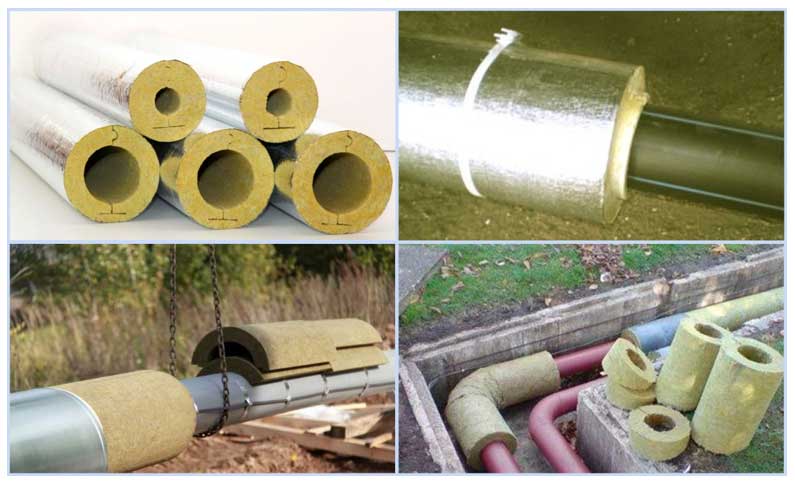

Fig. 7 Thermal insulation of sewer pipes in the ground with mineral wool
Mineral wool
Mineral wool is produced in two types - slag wool and basalt. The first one has a low density and high water absorption, it is not recommended to use it on metal surfaces and in living quarters - due to these properties, it has very limited use.
Basalt mineral wool, which is produced by melting basalt and forming a thin fiber from it, rightfully occupies a leading position among heaters, having the following useful properties:
- Low thermal conductivity 0.04 W / m. * C. promotes the widespread use of the material in the construction industry for insulating various types of surfaces and pipelines.
- The material is non-flammable, resistant to many chemicals and temperature extremes, and is environmentally friendly.
- Cotton wool is resistant to moisture, but can saturate it, therefore it is recommended to use it in a dry environment.
- Unlike glass wool, basalt wool has a higher density, making it easier to install and more efficiently used in conditions of pressure on the surface.
How to keep pipes from freezing
Insulation of sewer pipes in the ground is not required if they are significantly buried. For this, the bottom of trenches for sewer systems should be located below the mark of the deepest freezing of the soil. You can clarify such a mark using special maps that are compiled for each region based on long-term observations.


However, in particularly cold regions, the required sewerage depth can be simply exorbitant. The question immediately arises about the total cost of earthworks and other costs.
One more point: the sewage system laid at low elevations is rather difficult and expensive to repair. Rocky soils are a separate problem; it is also extremely difficult and costly to make deep trenches in them.
In some regions, the climate is unstable and almost completely unpredictable. Winter in any year can "crush" a month with temperatures below minus thirty. Next year, the area will be covered with a thick layer of snow (it reduces the freezing of the soil), and the frosts will be very moderate. In such conditions, depth calculations may be incorrect more than once.
Where deepening the sewer system is impossible or undesirable, the second option is useful - thermal insulation of sewer pipes in the ground. This event means that each element of the pipeline will be wrapped (lined, sprinkled, covered) with a special material with a high ability to retain heat inside and not let the cold out from the outside.
What should be good thermal insulation?
Ideally, measures to preserve sewer pipes from freezing should ensure:
- tightness of the pipeline, protection against moisture penetration;
- low thermal conductivity;
- incombustibility, resistance to aggressive soil influences;
- strength, long service life.
Many homeowners tend to choose methods that they could implement on their own. The question arises: what to choose from? Answer: you can insulate either the trench for the pipeline, or the pipes themselves.
How to insulate a trench
Everyone knows the insulating properties of slag, expanded clay, sawdust. Each of these materials can be poured into a trench and serve as a heat insulator, but only in low humidity conditions. When the soil freezes, the "wet" environment will promote the formation of ice in the spaces between the backfill particles.
To avoid this, it is necessary either to put together a wooden box, in which pipes and heat-insulating material are then placed, or to use ready-made reinforced concrete trays. The second method makes it much more difficult to independently insulate the sewer. In order to insulate the pipes themselves, they must be packed in some kind of insulating material with certain characteristics.
How to insulate a sewer in a private house
If it becomes necessary to insulate the sewer plastic pipe in the house, you can use all the above materials. From an economic point of view, ease of installation and aesthetics, the largest number of homeowners prefer isolon. It is simply fixed on the insulated surface through a side cut, can be glued or connected with adhesive tape. An additional advantage of the material is its highest noise absorption among all heat insulators.
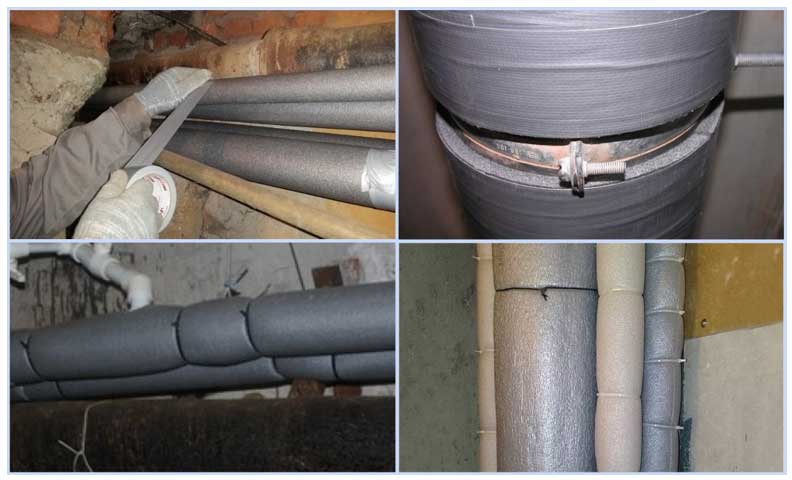

Fig. 11 Insulation of the sewage system in a private house with isolon
When deciding how to insulate the sewer in the ground, they proceed from climatic conditions, the convenience of work, the cost of materials. The optimal choice of heaters for underground sewerage with a wide variety is not too large - it can be an electric cable or a shell made of solid materials that do not allow moisture to pass through - foam or foam. Often a combination of heating cable and insulating shell is used for thermal insulation.
Insulation of the hood for the sewage system background riser
Separately, it should be noted the need to insulate the external sewage system, which is understood as a ventilated background riser (exhaust) - a sewer pipe brought to the roof (or to the surface of the earth from a septic tank) and providing ventilation of the pipeline.
The background riser is designed to suck in air so that when the toilet is flushed, the pressure in the system is equalized. And in the septic tank, gases are formed from the vital activity of bacteria, which are also removed through the background pipe.
The ventilation (background) pipe can freeze (condensate freezes and an ice plug forms) and needs to be insulated. Any material that is reliably protected from moisture and destruction by ultraviolet light is suitable for thermal insulation. For example, you can put a Stenoflex "stocking" on the pipe. The part of the pipe that is above the roof is insulated. And on top of the pipe, you cannot put a cap on, it must be free, otherwise it will freeze in this place.
How to insulate a background riser with your own hands
On the forum, one user suggested an interesting way to get rid of the build-up (freezing) of condensate in the background pipe.
It is necessary to take a copper wire (necessarily made of pure copper, without a braid, this is important), wind it into a voluminous, but at the same time "liquid" lump (so that air can easily pass through it). Put this lump of wire from above into the pipe, and bend the ends of the wire so that you can fix the wire at the top of the pipe (otherwise it will fall inside)
Slide this lump of wire from above into the pipe, and bend the ends of the wire so that you can fix the wire at the top of the pipe (otherwise it will fall inward).
The point lies in the chemical properties of copper, it has a very high thermal conductivity. Warm air rises through the pipe, copper accumulates heat and melts freezing condensate.
Conclusion
Insulation of the sewage system in a private house is an important measure that will preserve the normal permeability of sewer pipes in winter, prevent the pipeline from freezing and extend its service life

